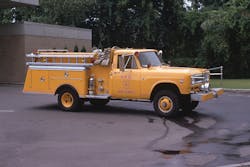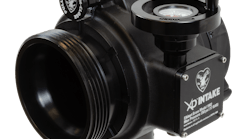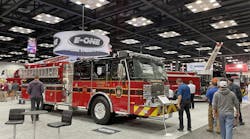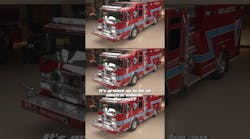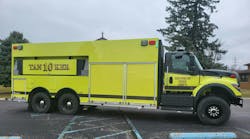During the past few months, there has been a spirited national discussion about healthcare and the leading causes of obesity in adults across the country. No matter which side of the political aisle you may be on, there is little doubt that our nation’s healthcare system is in need of an overhaul. The fire service long ago recognized the importance of physical fitness through many programs, including the “16 Firefighter Life Safety Initiatives,” promulgated by the National Fallen Firefighters Foundation (NFFF).
Among the initiatives, the significance of being healthy and physically fit is summarized in the following statement: “Develop and implement national medical and physical fitness standards that are equally applicable to all firefighters, based on the duties they are expected to perform.” While many departments have adopted and implemented health and welfare programs for their personnel, the apparatus we use to deliver emergency services unfortunately has not received the same attention.
Intended loads
The National Fire Protection Association (NFPA) has several well-established standards for use to reduce opportunities for departments to purchase or operate overweight apparatus. NFPA 1901: Standard for Automotive Fire Apparatus mentions in several areas the requirements placed on the manufacturer and the fire department with respect to weight and axle loading. Section 4.3 of the standard lists the responsibilities of the fire department to determine the hose load, tools and equipment that will be carried on the apparatus. Failing to provide this information results in the minimum equipment payload allowance listed in Table 12.1.2 to be used by the manufacturer when determining the required chassis gross vehicle weight rating (GVWR) for the apparatus.
So what does all this mean? A department apparatus committee that is designing a rescue engine must develop a comprehensive tool and equipment inventory with weights, including both space and weight allowances for future expansion. This inventory is then given to prospective manufacturers to determine the appropriate axles, tires and suspension components that will safety carry the intended load on the vehicle, including personnel.
Unfortunately, it is not difficult to find overloaded pieces of apparatus, regardless of age or design characteristics. Over the past few years, we have reviewed hundreds of in-service units and identified the following:
• A less than five-year-old custom pumper equipped with a 750-gallon water tank and five-inch hose was overweight on the rear axle by more than 2,300 pounds
• An eight-year-old custom pumper tanker equipped with a 2,000-gallon water tank with seating for six personnel. When operating with a crew of six, the front axle would be overloaded by almost 1,200 pounds.
• A 17-year-old custom rescue engine was overloaded on the front axle with no personnel on board and the rear axle within 800 pounds of the axle rating.
• An aluminum body mini pumper with a chassis rated at 12,000 pounds was overloaded by 600 pounds on the rear axle.
Each of these departments was unaware of its apparatus weights and axle loading until it was brought to their attention that NFPA 1911: Standard for the Inspection, Maintenance, Testing, and Retirement of In-Service Automotive Fire Apparatus requires that all units be annually weighed to confirm their in-service weight. Chapter 16 of NFPA 1911 describes in detail the procedure for weighing the apparatus. Most fire departments can access certified scales, which are available at transfer stations, sand-and-gravel companies and salvage yards. State and local police agencies can also provide this service for a fire department to obtain the necessary information to validate the axle weights on each apparatus.
Effects of extra weight
The annual verification of in-service weight is one of several testing requirements that should be conducted by the fire department or maintenance staff. Being overweight can impact the handling, braking and steering of the apparatus and is often indicated during routine operations. Maintenance records may indicate premature brake and tire wear on overweight apparatus; should the unit be involved in an accident, axle weight will certainly come into question.
Over the years, certain types of apparatus have been more suspect of being overweight including fuel oil tankers that are converted into water tenders. The frequency of tanker and tender accidents caused the U.S. Fire Administration (USFA) to issue a detailed study of tanker operations. Factors cited in the report included inadequate driver training, improper apparatus modifications and vehicle weights. As a result of this study and other factors, Section 4.15.3 of NFPA 1901, 2009 edition, requires that apparatus with a GVWR of more than 50,000 pounds or water/foam tanks greater than 1,250 gallons are limited to a maximum road speed of 60 mph.
While this reduction in road speed impacts newly built tankers, aerial devices and many rescue engines, the reduction in speed does not imply that the apparatus can be safe to operate if it is overloaded. While interstate truck commerce is regulated at a state level with respect to vehicle weights, many localities exempt fire apparatus or give them an informal exemption from these regulations. The responsibility to monitor the in-service weight of apparatus falls squarely on the fire department. As the old adage states, “Ignorance of the law is no excuse.” Make certain what your state regulations cover. An informal exemption will not hold up in a court of law if your actions are called into question.
Every fire department should develop a procedure to conduct annual in-service weight testing of all apparatus and document the results. The individual front and rear axle weights as well as the overall weight must be compared against the ratings established when the apparatus was delivered. This information can generally be found inside the chassis cab, where the original body builder would post the axle ratings based on the lowest rated chassis component of the axle, tires, wheels and suspension. Certain sizes of tires may have been certified for a higher weight capacity than those stamped on the tire sidewall, as fire and emergency vehicles are considered to have an intermittent duty cycle. If there are questions with respect to the components on a specific apparatus, the manufacturer’s original bill of materials and component lists should be consulted to verify the actual weight ratings.
Weight analysis
Departments that are specifying new apparatus should, in addition to developing the tool and equipment inventory, include a requirement that each bidder provide a detailed weight analysis for the apparatus being proposed. This documentation will indicate the anticipated front and rear axle loads for the vehicle showing the individual weights of cab and chassis, personnel, body compartments, hose, tools and fixed equipment and how these weights are distributed on each axle. Using this weight analysis provides a starting point for the life cycle of the apparatus and should be used to verify its weight prior to acceptance by the fire department. The documentation of the apparatus weight can also be used to verify the proposed tire, axle and suspension components to be supplied by each vendor.
Like many things in life, fire apparatus do not tend to get lighter after several years of service. Many fire and emergency departments proclaim they are “all-hazard” agencies, and this mission often includes an extensive array of technical rescue, hazardous materials and fire support equipment that can have an impact on vehicle weight and road performance. Do not let the age, manufacturer or outward appearance of your apparatus fool you into believing that the vehicle is not overloaded and is safe for continued operation. Weigh, document and inspect each apparatus, as your life and the safety of those around you depends on it, every time your respond.
NFPA 1901 TABLE 12.1.2
Miscellaneous Equipment Allowance
? PUMPER
Less than 250 cubic feet of compartments
2,000 pounds
? PUMPER
More than 250 cubic feet of compartments
2,500 pounds
? MOBILE WATER SUPPLY
All
1,000 pounds
? AERIAL/QUINT/TOWER
All
2,500 pounds
Tom Shand and Michael Wilbur will present “NFPA Standards & EPA Regulations” at Firehouse Expo 2013, July 23-27 in Baltimore, MD.
